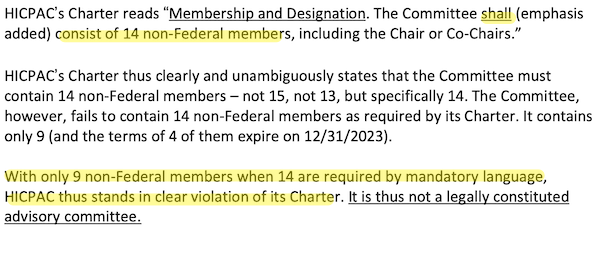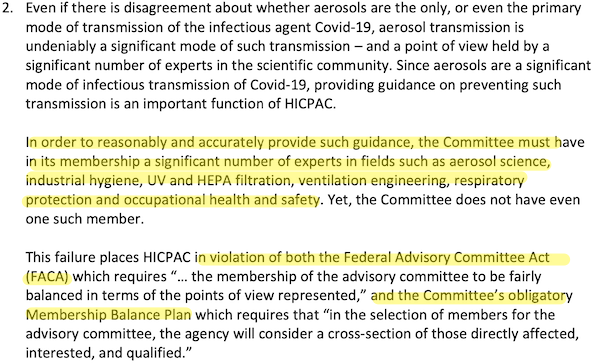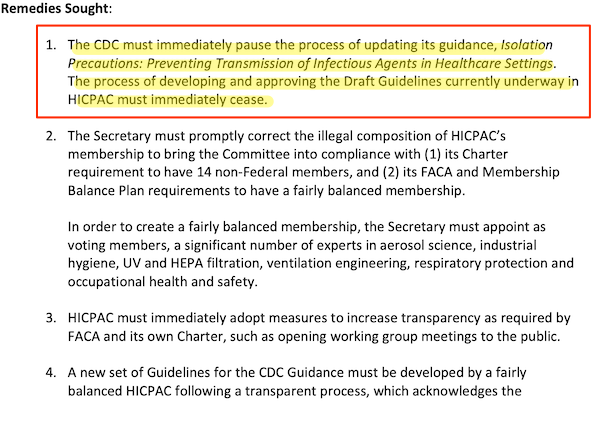By Lambert Strether of Corrente.
Readers who have been following our HICPAC journey (CDC’s Healthcare Infection Control Practices Advisory Committee) will be aware that HICPAC has now dropped — apt word! — a draft version of the PowerPoint (“Isolation Precautions Guideline Workgroup“) presented on June 8; its title: “Healthcare Personnel Use of N95 Respirators or Medical/Surgical Masks for Protection Against Respiratory Infections: A Systematic Review and MetaAnalysis.” I need a short title, so I’m going to use “Review,” even though “Baggy Blues 4EVA” would be a more accurate choice. This should surprise no one. As I wrote back in July, in my analysis (“personnel is policy”) of the composition of the Committee, this outcome should surprise no one:
1. None of the hospitals with which the HICPAC members are affiliated have a policy of universal masking.
2. Though some of the HICPAC members look not unfavorably on masking, and on airborne transmission generally, none could be characterized as advocates.
3. Favorability toward universal masking, ideally with N95s, is inversely correlated with institutional clout; Mass General/Brighams vehemently opposed; the University of North Carolina and Barnes-Jewish persuadable.
4. The HICPAC committee members are in the pleasant position of being able to ratify as guidance policies that their institutions have already adopted (i.e., no universal masking, let along universal masking with N95s, going forward). One might, indeed, go so far as to characterize the HICPAC meeting as theatre, were there drama involved in a clearly pre-determined outcome[2].
In other words, the fix was in. That doesn’t mean that HICPAC’s exercise in stochastic eugenicism is a done deal, or that it should not be opposed.
In this post, I will not put on my yellow waders and do a close reading of “Review,” a Gish Gallop which weighs in at a robust 80 pages. The key point here is that the process through which “Review” was “dropped” is fatally flawed. I will show those flaws at a high level by presenting a sample message that you deliver to the HHS Office of the Inspector General (OIG) by phone. Then I will present the complaint brought against HICPAC to the OIG by the World Health Network, which will show those flaws in greater detail. (The full Complaint is embedded in the Appendix at the end of this post as a PDF file, along with its supporting material.)
How to Call the HHS Inspector General
Alert reader SGD throws the following over the transom. This puts the OIG complaint in short form, and should give you inspiration for your own call:
In her public testimony at the HICPAC meeting this past Friday (11/3), Kathleen Turturice [National Nurses United public supporter, here] gave the number for calling the Office of the Inspector General: 202/619-3148. Her testimony gives a brief capsule of the Complaint, and if someone has not yet read it, they can get the gist of it from what she said.
If people would like to call the IG in support, they should make a statement in their own words and be sure to be courteous to whomever answers the phone. I don’t want to tell people what to say – it’s important that they speak for themselves in their own words, so please don’t quote me about what to say.
If I were calling, I’d say something like this:
• “Please investigate the complaint filed by World Health Network this past October 29. I’m very upset with what’s going on at HICPAC. It looks like their membership violates the law. HICPAC does not have the required number of members and doesn’t have one aerosol expert as a voting member. That makes them unable to adequately address the problem of the aerosol transmission of Covid and diseases like it. Please investigate the complaint filed by World Health Network this past October 29.”
(The first and last sentence duplicate to make sure the gist gets written down.) I’m sure that there are many NC readers who can translate these suggestions into their own words — some of them with credentials the OIG is sure to respect! And if any of you take notes and want to share, feel free to send them to me for a follow-up.
Note that the HHS OIG has serious clout. From the About page:
Since its 1976 establishment, the Office of Inspector General (OIG) has been at the forefront of the Nation’s efforts to fight waste, fraud and abuse and to improving the efficiency of Medicare, Medicaid and more than 100 other Department of Health & Human Services (HHS) programs. OIG is the largest inspector general’s office in the Federal Government with approximately 1,650 personnel.
Wikipedia:
The Office of Inspector General (OIG) for the United States Department of Health and Human Services (HHS) is responsible for oversight of the United States Department of Health and Human Service’s approximately $2.4 trillion portfolio of programs.
The Case Against HICPAC in the Complaint to the Inspector General
I’m going to present big chunks of the Complaint here, helpfully highlighted for your perusal. I’m also going to intersperse them with some posts of my own, because [lambert preens] a smol avian creature told me that my posts triggered some thought processes in the minds of the actual lawyers who put the complaint together for World Health Network (WHN).
The bold-face names:
Number of Committee Members:

I must admit that I missed this!
Composition of the Committee:

From [lambert preens] “CDC’s HICPAC Prepares to Violate the Letter and Spirit of the Federal Advisory Committee Act at Its August 22 Anti-Mask Teleconference“, after discussing GSA guidance on the Membership Balance Plan:
It’s plain as day that HICPAC’s membership is not “divergent” as FACA understands the term; every one of its members is affiliated either with a hospital or a medical care facility. Conflicts aside, the controlling assumption can only be that hospital staff have nothing to learn about infection control from anyone outside their milieu. Surely such mental and ideological inbreeding is exactly what an open and transparent process seeks to prevent? (“Sunlight is the best disinfectant,” as they say.) CDC has an entire institute, NIOSH, with expertise in “respirators and masks.” Are we seriously to believe that NIOSH has nothing to contribute to HICPAC on masking? Or ventilation? Or training? Even if NIOSH doesn’t sit on the committee, why are they not invited experts? Why on earth does HICPAC’s draft “Isolation Precautions Guideline Workgroup” deliverable (PDF), which is driving masking policy and the infection model for HICPAC, not even mention NIOSH?
Records violations:

Also from [lambert, still preening] “CDC’s HICPAC Prepares to Violate the Letter and Spirit of the Federal Advisory Committee Act at Its August 22 Anti-Mask Teleconference“:
Where are the 2023 minutes? (To be fair, the CRO writes that the GSA’s FACA “guidance does not indicate that meeting minutes must be published in advance of the committee’s next meeting date.” CDC says although HICPAC meetings may occur “up to” 8 times a year, this year (at least according to the Federal Register) the only previous 2023 meeting — oddly; was there nothing to discuss (in public?) — was on June 8. Surely 67 days is enough time for a large Federal agency to prepare meeting minutes?)
Remedies:

IANAL, so of course I forgot the remedies!
I bring these to your attention not merely to preen, but to reinforce that Naked Capitalism does have impact, however unexpected the trajectory, in the real world (and big ups to the WHN for filing the complaint, and to the legal beagles who drafted it). This is what blogs do, and what your support enables.
Conclusion
HICPAC’s “Review” is an murderous abomination, an affliction for patients and hospital workers alike. From CNN, and it’s a pleasure to see coverage of HICPAC move to the mainstream; I’m sure it’s the last thing those goons want. On workers:
In July, NNU drafted a letter to CDC Director Dr. Mandy Cohen voicing its concern that the new guidelines, if implemented as drafted at the time, would significantly weaken protections for health care workers. Thousands of health care workers died during the Covid-19 pandemic and others have been disabled by long Covid.
NNU’s [Jane] Thomason fears that if [since] the new guidelines walk back protections for health care workers, the US could see a similar catastrophe during the next pandemic.
“What they are working on … it’s going to impact patients and health care workers in so many different places. It’s going to determine whether some of them live or die, quite honestly,” Thomason said.
And patients:
During public comment periods on Thursday and Friday, HICPAC heard from several patients with long Covid or conditions that lower their immune function that they did not feel safe accessing health care because they couldn’t be sure their providers would wear protective masks when treating them.
Christine Braile said she was commenting on behalf of her 16-year-old son, who has a condition that weakens his immunity called primary immune deficiency. She said he is now living with long Covid after catching the infection from a home infusion nurse who did not mask properly.
“Loosening the patient protections for respiratory diseases, especially Covid will only hurt patients and further decimate staffing levels,” Braile told the committee.
“I am deeply afraid of being in a situation where avoiding health care is not an option,” said Seifer Almasy, who spoke as a member of the public. He said he was recently in that situation when he decided he couldn’t put off getting his updated Covid-19 and influenza vaccines. He said he made 34 phone calls and was on hold for more than four hours to find a provider that would wear an N95 while giving him his vaccines.
And on HICPAC’s institutional capture:
Dr. David Michaels, an epidemiologist and professor at the George Washington University School of Public Health, said the new guidelines should have benefited from all the knowledge about the transmission of respiratory infections gleaned during the pandemic. Instead, he said, “this is going backwards.””I think what’s happened here is the members of this committee came to us with prejudgment on how infection control should be applied,” said Michaels, who was part of a group of experts that addressed HICPAC with its concerns about the draft during an October listening session.
“This committee has no members who have expertise in worker protection, or in aerosol science,” said Michaels, who is also the former head of the Occupational Safety and Health Administration. “And so their view of infection control is a hospital-based view and hasn’t changed in decades.”
Yep. Make that call. Let’s save some lives.
NOTES
[1] See, e.g.
APPENDIX
Here is the World Health Network Complaint:
FINAL PDF – Complaint of Gross Misconduct
Here is the Evidence and Analysis in support of the complaint. Many hilarious moments!
FINAL PDF – Analysis & Evidence Re IG Complaint


